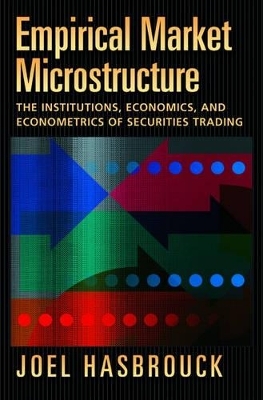
Empirical Market Microstructure
Oxford University Press Inc (Verlag)
978-0-19-530164-9 (ISBN)
The interactions that occur in securities markets are among the fastest, most information-intensive, and most highly strategic of all economic phenomena. Empirical Market Microstructure is about the institutions that have evolved to handle our trading needs, the economic forces that guide our strategies, and statistical methods of using and interpreting the vast amount of information that these markets produce. The empirical methods
discussed in the book draw on the power of multivariate linear time series analysis. The book discusses the application of univariate ARMA analysis to trade prices, vector autoregressions to price and order
data, and vector error correction models to situations where the same security is traded in many markets. In these models, the tools of random-walk decomposition and co-integration emerge as important to specification and interpretation. The statistical specifications dont simply arise, however, as progressively more refined descriptive models; they have strong economic underpinnings arising from asymmetric information, inventory control, and the strategies of their
participants. These topics are discusssed, interleaving with and emphasizing the connection to the statistical models. From a practical viewpoint, many of these models will be
estimated to calibrate real-world trading strategies. Some market participants will be trying to discern strategies that generate profits from short-term trading. A much greater number, though, will be trying to accomplish trades that help diversify, hedge or reallocate a portfolio. Trading is not, for these agents, their primary economic purpose. They are simply trying to satisfy their trading needs at a minimal cost. The final part of the book discusses how these costs are measured, and
strategies to minimize them--both by splitting orders over time, and by the judicious use of limit orders. The book includes numerous exercises; solutions and other supporting
materials are available on the author's web site.
Joel Hasbrouck is the Kenneth G. Langone Professor of Business Administration and Professor of Finance at the Stern School of Business, New York University. In addition to teaching at Stern, he has served as a constultant to the New York Stock Exchange and the American Stock Exchange, and on the scientific adviosry board of ITG, Inc. and Nasdaq's economic advisory board.
1: Introduction
2: Trading Mechanisms
3: The Roll Model of Trade Prices
4: Univariate Time-Series Analysis
5: Sequential Trade Models
6: Order Flow And The Probability of Informed Trading
7: Strategic Trade Models
8: A Generalized Roll Model
9: Multivariate Linear Microstructure Models
10: Multiple Securities and Multiple Prices
11: Dealers and Their Inventories
12: Limit Order Markets
13: Depth
14: Trading Costs: Retrospective and Comparative
15: Prospective Trading Costs and Execution Strategies
| Erscheint lt. Verlag | 18.1.2007 |
|---|---|
| Zusatzinfo | 24 line illus. |
| Verlagsort | New York |
| Sprache | englisch |
| Maße | 237 x 165 mm |
| Gewicht | 449 g |
| Themenwelt | Wirtschaft ► Betriebswirtschaft / Management ► Finanzierung |
| Wirtschaft ► Volkswirtschaftslehre ► Mikroökonomie | |
| Wirtschaft ► Volkswirtschaftslehre ► Ökonometrie | |
| ISBN-10 | 0-19-530164-1 / 0195301641 |
| ISBN-13 | 978-0-19-530164-9 / 9780195301649 |
| Zustand | Neuware |
| Haben Sie eine Frage zum Produkt? |
aus dem Bereich


